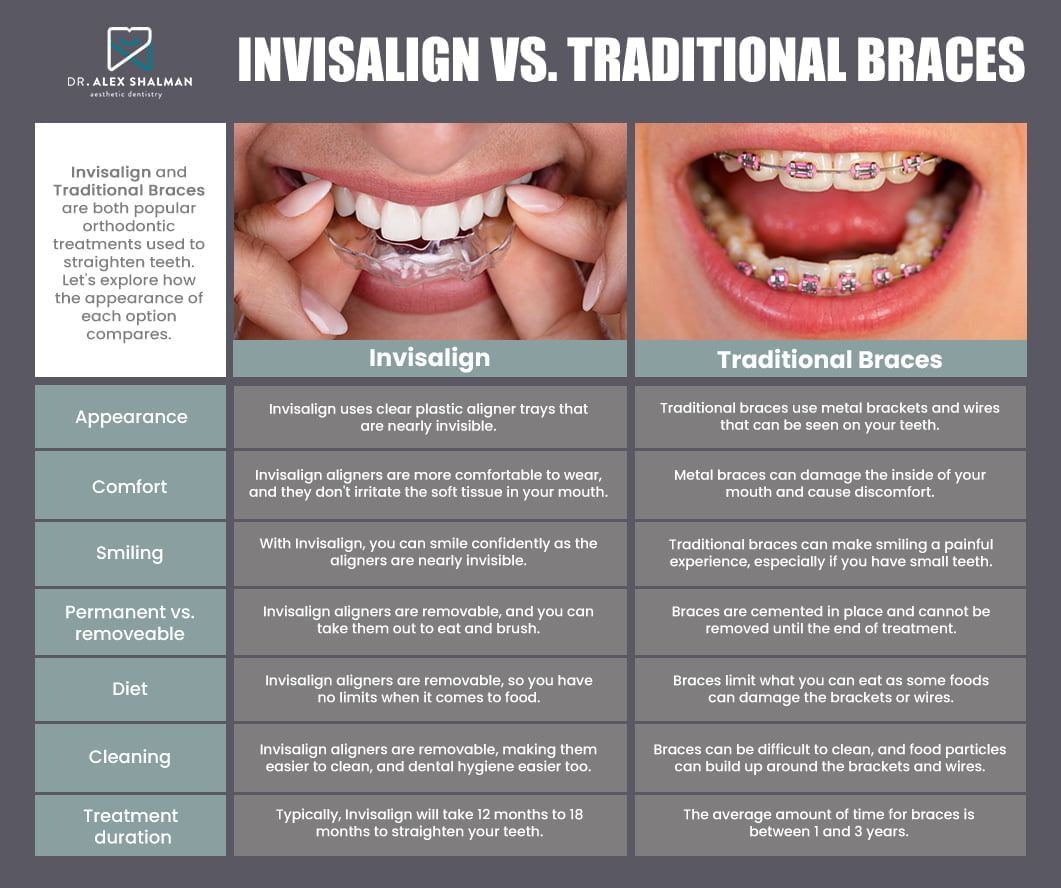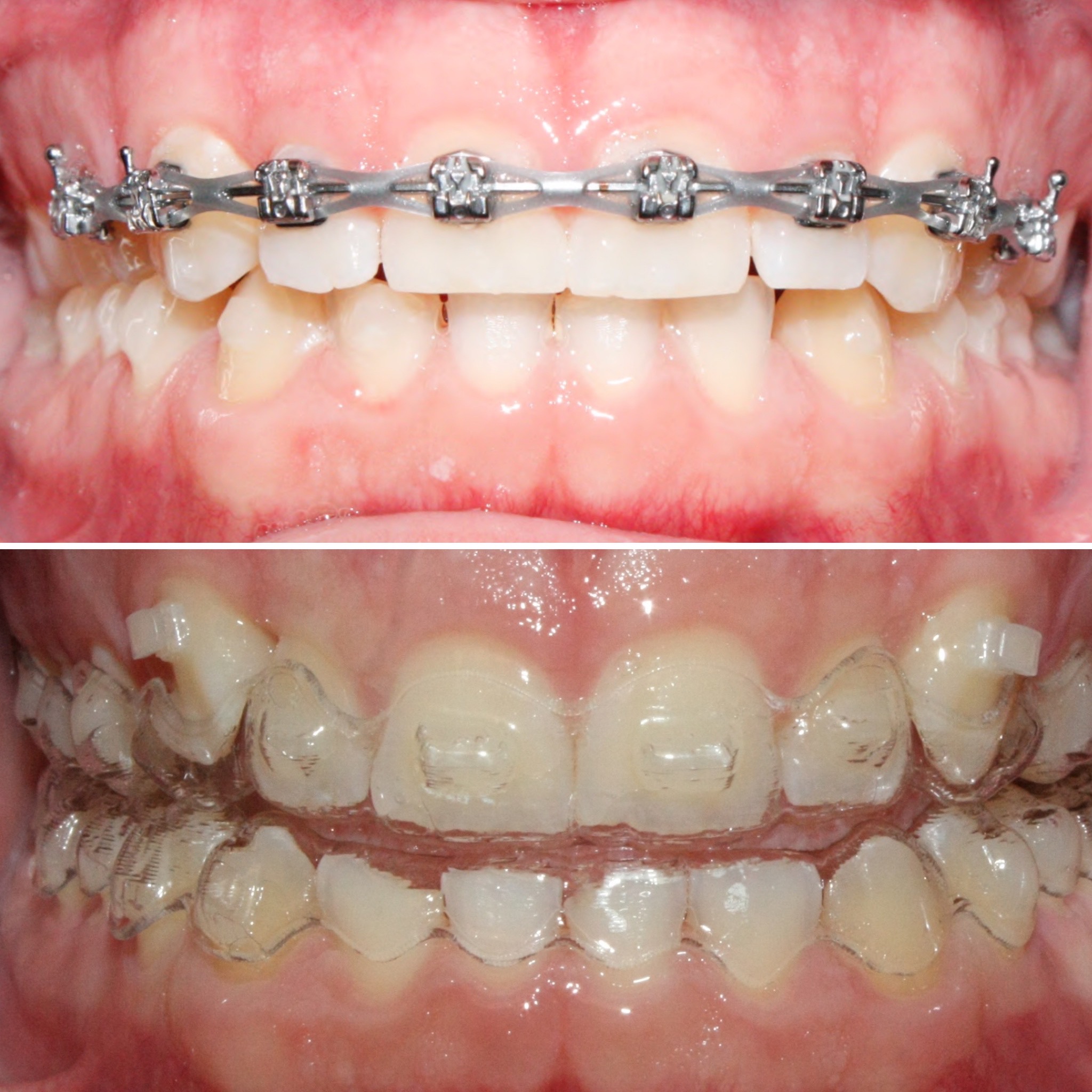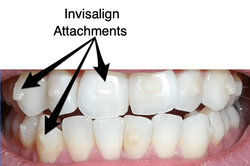The Ultimate Comparison: Invisalign vs. Traditional Braces for Adults
The Ultimate Comparison: Invisalign vs. Traditional Braces for Adults
Blog Article
Invisalign vs. Conventional Dental braces: Which Choice Is Right for You?
When taking into consideration orthodontic therapy, the option in between Invisalign and typical dental braces presents a number of important variables that merit cautious analysis. Invisalign supplies a discreet alternative with detachable aligners, while standard braces offer a more noticeable yet efficient remedy for severe imbalance. Each option includes distinctive advantages and disadvantages connected to looks, comfort, treatment duration, and cost. Comprehending these subtleties is crucial for making an informed choice that aligns with your personal preferences and way of living. The inquiry continues to be: which alternative will best satisfy your orthodontic needs and expectations?
Review of Therapy Options

In contrast, conventional dental braces are composed of metal braces and cables that are adhered to the teeth. This approach uses continual pressure gradually to achieve positioning. While reliable for complicated orthodontic concerns, typical dental braces call for routine check outs for modifications and can position challenges in keeping dental health as a result of the difficulty of cleansing around braces and cords.
Both options have their qualities, and the option usually pivots on specific oral problems, way of life choices, and client compliance. Ultimately, getting in touch with an orthodontic specialist is crucial for determining the most appropriate treatment plan customized to specific needs. Understanding the subtleties of each option can considerably affect the overall success of orthodontic therapy.
Aesthetic Factors To Consider
A significant element affecting the option between Invisalign and conventional braces is the aesthetic appeal each therapy offers. Invisalign aligners are crafted from clear plastic, making them virtually invisible when used.
On the other hand, typical dental braces contain metal braces and cords, which can be more recognizable. While improvements in orthodontic modern technology have resulted in the advancement of smaller brackets and tinted elastics, typical braces still maintain an even more noticeable profile. For some individuals, the exposure of dental braces might deter them from seeking necessary therapy.
Eventually, the selection between Invisalign and standard braces may rest on personal choices relating to aesthetic appeals. Patients that prioritize discretion commonly lean towards Invisalign, while those who are much less worried regarding visibility may select conventional dental braces. Recognizing the visual implications of each choice is critical for making an educated choice that straightens with one's lifestyle and choices.
Comfort and Convenience

In terms of ease, Invisalign aligners are removable, enabling people to appreciate their preferred foods without constraint and preserve optimal dental health. Brushing and flossing are simplified, as the aligners can be taken out throughout these regimens, whereas conventional braces need cautious navigating around cords and brackets.
In contrast, traditional dental braces require routine adjustments, making them much less practical for those with active routines. On the whole, the convenience and benefit of Invisalign make it an enticing option for lots of people looking for orthodontic therapy.
Therapy Duration and Effectiveness
While both visit this site Invisalign and standard braces work in remedying oral imbalances, the period of treatment can differ dramatically in between both options. Normally, Invisalign therapy can take anywhere from 12 to 18 months, depending upon the complexity of the instance. The clear aligners function by progressively shifting teeth right into their desired placements, and regular follow-ups with an orthodontist aid ensure progression remains on course.
On the other hand, conventional braces often require a longer dedication, usually varying from 18 months to three years. This results from their set nature and making use of cables and brackets, which can be much more reliable for serious misalignments and intricate cases (Invisalign). The treatment performance of typical braces is well-documented, as they enable precise changes and higher control over tooth activity
Eventually, the selection between Invisalign and conventional braces might depend upon both the awaited therapy period and the particular dental issues available. Consulting with an orthodontist is crucial, as they can offer tailored referrals based on specific demands, making certain the chosen method aligns with preferred outcomes and durations.
Price Comparison and Insurance Coverage Options
Expense plays a substantial role in the decision-making process for individuals thinking about orthodontic treatment, whether choosing Invisalign or conventional braces. On average, the expense see post of Invisalign ranges from $3,000 to $8,000, while standard dental braces generally set you back between $2,000 and $6,000. Factors influencing these expenses consist of the intricacy of the case, the period of treatment, and geographical area.
Numerous dental insurance plans offer partial coverage for orthodontic therapies, yet the specifics can vary widely. Usually, conventional braces might be a lot more often covered by insurance coverage plans contrasted to Invisalign, which some insurance providers categorize as a cosmetic procedure.
Furthermore, several orthodontic methods supply flexible layaway plan, making both therapy alternatives much more available. Individuals should make inquiries concerning possible financing alternatives and discount rates for ahead of time settlements. Assessing the total cost, including insurance policy advantages and settlement plans, is essential for making a notified choice that lines up with both visual preferences and budget plan factors to consider.

Verdict
In summary, the option between Invisalign and traditional dental braces depends upon multiple variables, consisting of aesthetic preferences, convenience, therapy duration, and cost. Invisalign supplies a discreet, detachable alternative that assists in oral hygiene and dietary flexibility, while traditional dental braces might be preferable for complex oral problems and frequently come at a lower price point. Inevitably, consultation with an orthodontist is essential to assess individual scenarios and determine one of the most ideal therapy alternative for attaining ideal dental alignment.
When considering orthodontic therapy, the option between Invisalign and typical dental braces provides a number of important elements that merit careful examination.Comparing Invisalign and typical dental braces discloses distinctive treatment alternatives for orthodontic modification.While both Invisalign and traditional dental braces are effective in dealing with dental misalignments, the period of therapy can differ substantially between the 2 alternatives.Cost plays a considerable function in the decision-making process for individuals taking into consideration orthodontic treatment, whether deciding for discover this info here Invisalign or standard dental braces.In recap, the option in between Invisalign and conventional dental braces pivots on multiple variables, consisting of aesthetic choices, comfort, treatment period, and expense.
Report this page